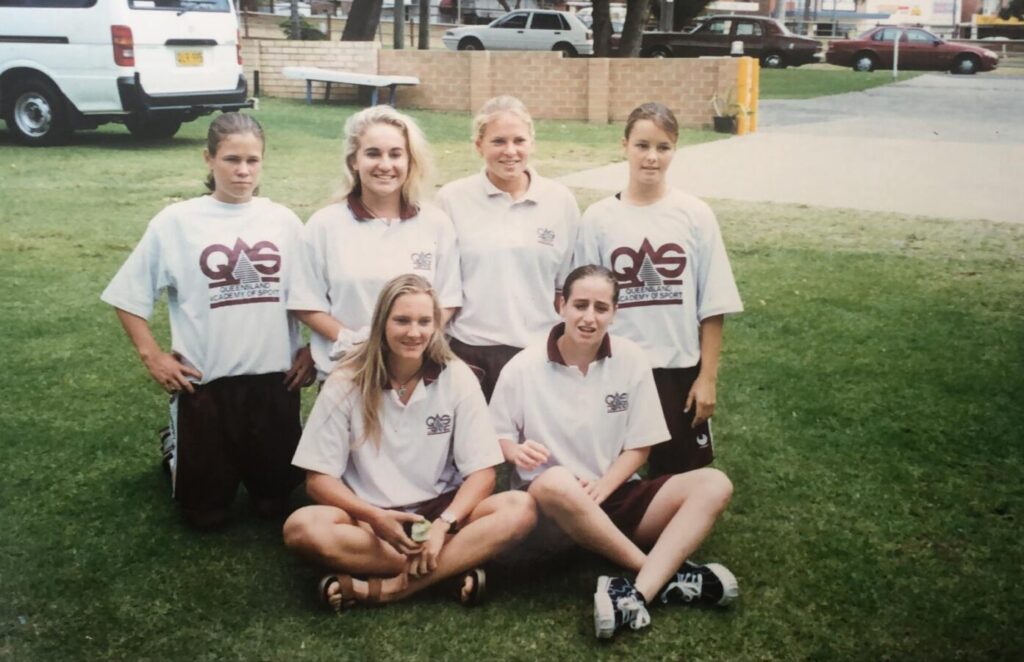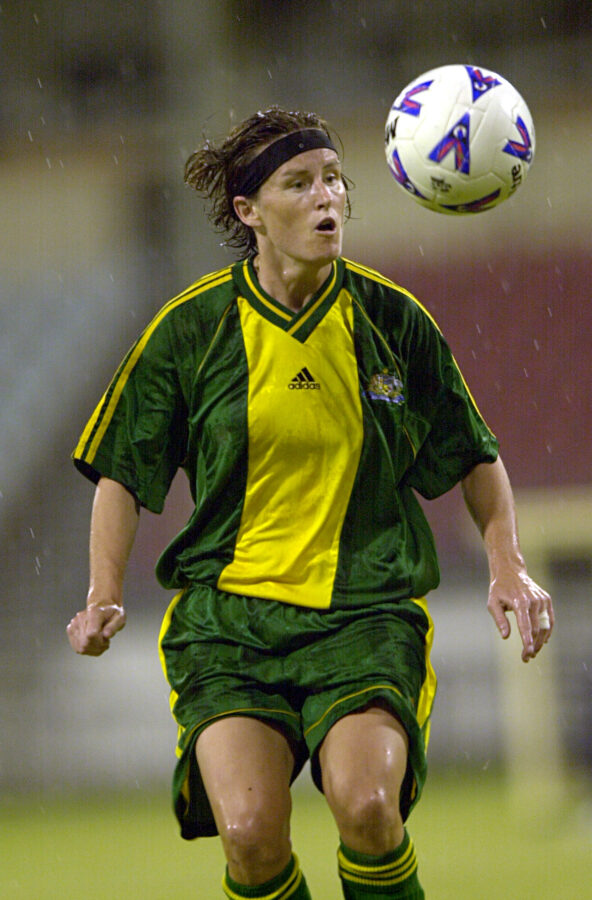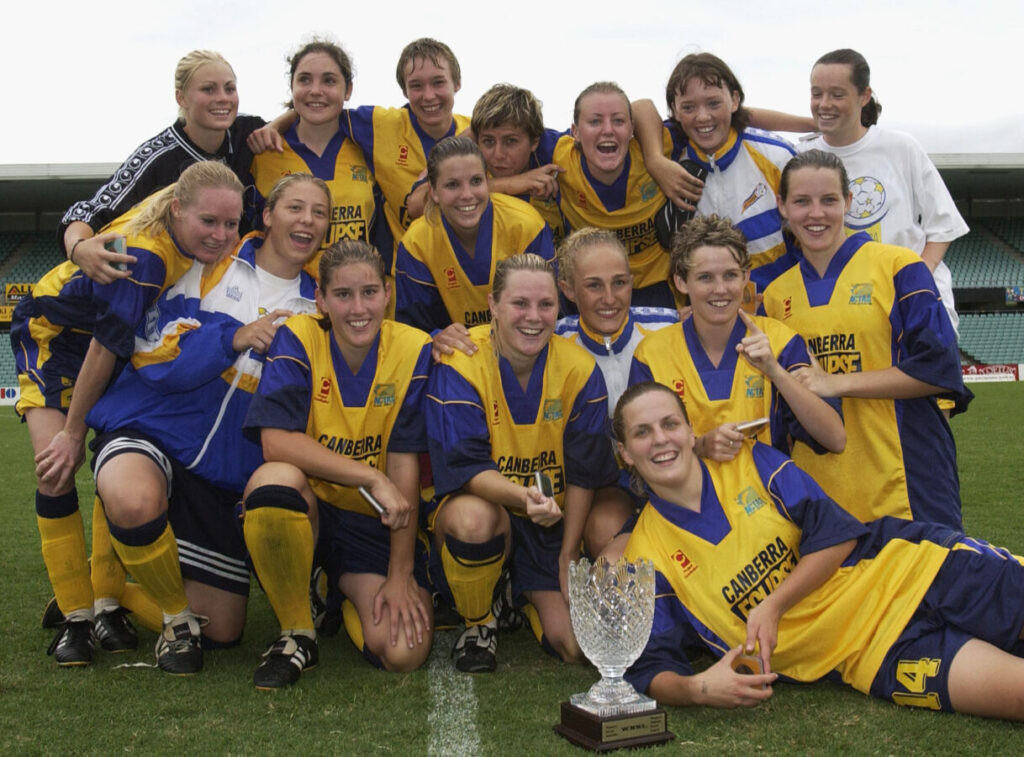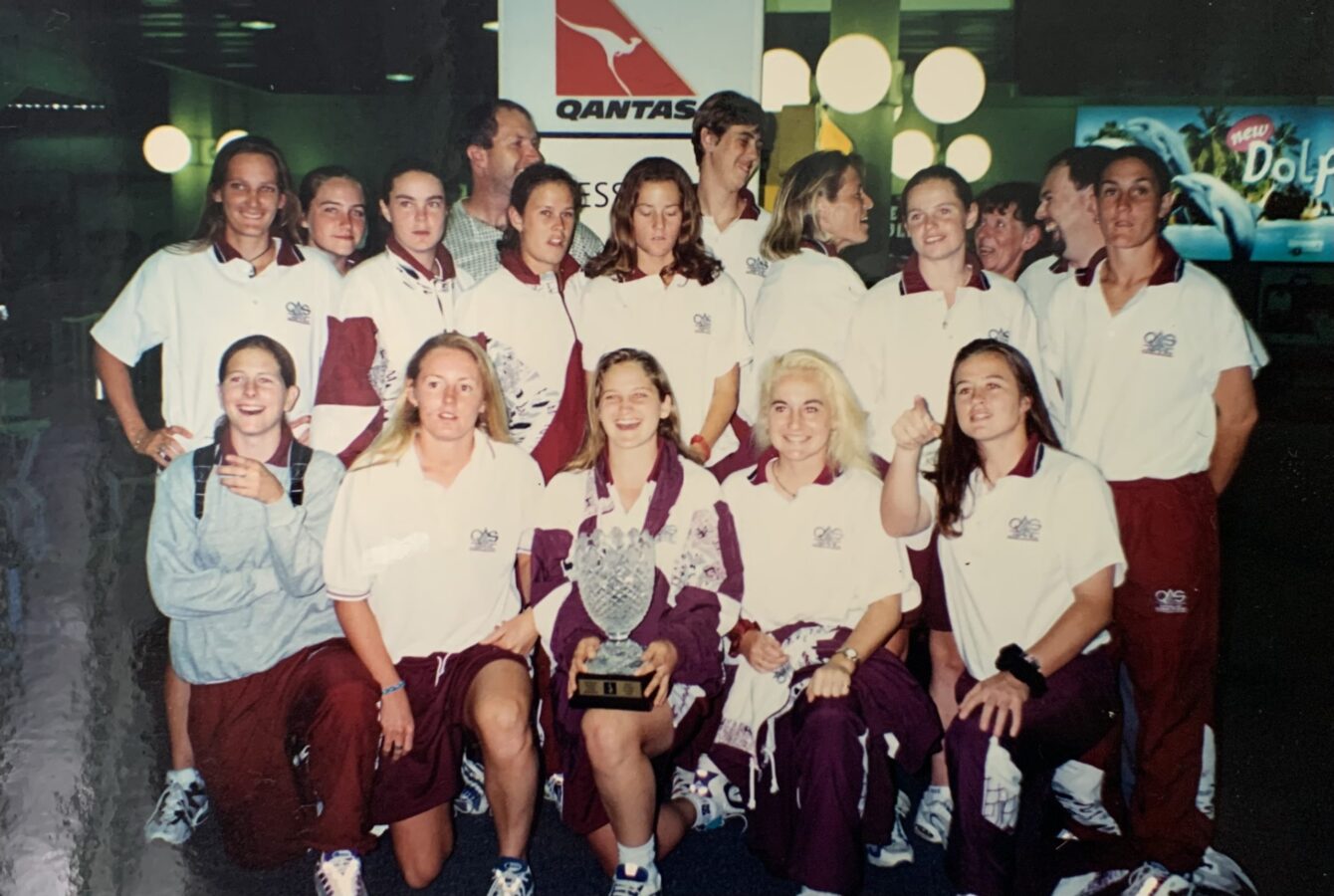
By Joe Gorman
Tammie Thornton doesn’t remember much about playing for Queensland in the inaugural season of the Ansett Summer Series in 1997.
But she will never forget the feeling of training at Perry Park in Brisbane and travelling around the country to take on other state academy sides.
Born and raised in Cairns, Thornton started playing football at 14, made the big move south to join the Queensland Academy of Sport at 18 and made her debut for the national team in 1996, at the age of 20. The new competition intersected with her arrival as a senior player.
Thornton, now 46, was one of 388 players who participated in Australia’s first ever national women’s football league.
She wasn’t the longest-serving or the most famous player, but she was part of a largely forgotten generation of footballers who dug the well for today’s Matildas and A-League Women.
“It wasn’t just a once a year tournament; it was week-in, week-out,” says Thornton. “I thrived in that environment and I loved that it was a scheduled competition. It was a short season but I treated it as a national league, because it was the best league with the best players.”

The birth of the Ansett Summer Series can be traced back to September 1993, when the International Olympic Committee declared that women’s football would become part of the program from 1996, and that the 2000 Olympics would be held in Sydney.
Suddenly, the Australian Women’s Soccer Association was tasked with building up the national women’s football team to compete at a major tournament on home soil.
“It was a sliding doors moment for Australian women’s football,” says former AWSA chief executive Peter Hugg. “I forget the exact figures, but we went from something like $20,000 per year in government funding to something in excess of $1 million.”
Between 1994 and 1996, the AWSA employed Tom Sermanni as coach, began rebranding the team as the Matildas to lift its public profile and arranged regular friendly games against better opposition.
Most importantly, it developed an Olympic Athlete Program by establishing female football academies via the Australian Institute of Sport and its state affiliates.
“When I took over the national job, we had to set up the Intensive Training Centres,” says Sermanni. “The first thing that we did was put them in line with the boys programs. But within about two months we realised that this was a mistake, because there had been almost no development in women’s football.”
And so a national league was born, with Ansett Airlines as its major sponsor. From 1996 to 2004, the competition brought together the Intensive Training Centres, known as ITCs, and typically ran for a couple of months during the summer.
It was participated in by young women who chased a dream, not for the promise of fame or fortune but for the pride of pulling on state colours, the possibility of representing their nation at the Olympics and the pure enjoyment of playing their sport at the highest possible level.
“I think in those times where you didn’t get paid, you just gave everything you have,” says Sharon Black, a gun striker from South Australia.
“It was something we were passionate about and we loved. The greatest joy, for me, was always representing my state and then my country.”
The league kicked off in December 1996 with Victoria, South Australia and ACT in the Southern Conference and Northern New South Wales, Queensland and New South Wales in the Northern Conference. South Australia set an early benchmark with a 6-1 win over Victoria. Black scored four goals.
“I’m sure it would have been great service from my teammates,” Black recalls, still humble all these years later. “I was never the fittest person, but one of my strengths was having a good eye for goal.”
After nine rounds played in six cities around the country, Queensland and New South Wales finished equal second on 14 points, with the same number of wins, draws and losses and the same goal difference.
It was decided that the two sides would meet in a 40-minute playoff final to determine which team would play the grand final against South Australia.
In the end, Queensland won the unusual tiebreaker after a tense penalty shoot-out, before beating South Australia the next day thanks to a double from veteran striker Lisa Dunne. It was Queensland’s fifth game in five days.
“I am not aware of any men’s competition, at this level, that would be so demanding of players,” observed Eye on Soccer, the official publication of the Queensland Soccer Federation.

The fact that the inaugural final was contested by Queensland and South Australia, rather than the more populous states of New South Wales and Victoria, was proof of concept.
“It helped unearth players that probably wouldn’t have got opportunities, particularly from states such as South Australia,” recalls Sermanni.
Sharon Black was one of these women. Before the Ansett Summer Series, she was playing for Sturt Marion in the local Adelaide competition and trying to keep her fitness up through extra training sessions.
“In South Australia there wasn’t a great deal of national team players, so you had to do the work on your own, which I found quite difficult,” she recalls.
“But once the Summer Series started, we trained three or four times a week, so my fitness improved, my professionalism improved and my strength improved.
“As one of the smaller states on the national playing field, it brought the standards up. There was pride and enthusiasm and excitement around having a state team that trained together.”
Black toured Europe and the United States with the Matildas in 1997, won the inaugural Julie Dolan Medal in 1998 and scored two goals in the 1998-99 grand final to deliver South Australia its first national league title.
She was also selected as part of the first group of players to take up a full time residential scholarship at the AIS in preparation for the Sydney Olympics.
Competition for a spot in the Olympic squad was fierce as young contenders were unearthed in the Ansett Summer Series. In the 1999 season, for instance, 15-year-old South Australian Ann-Marie Vozzo won the Julie Dolan Medal and the Young Player of the Year Award, while 17-year-old Queensland striker Belinda Dawney won the Golden Boot.
A year later, 15-year-old future Matilda Selin Kuralay won the Young Player of the Year Award – the first Victorian to win a national league honour – and 23-year-old Taryn Rockall became the first player to win the Julie Dolan Medal and the Golden Boot in the same season.
Rockall had missed the cut for the Olympic Games that year through injury, but credits the league with exposing her to a higher level of competition. She was regularly competing against top players from other states and training alongside legendary Matildas such as Anissa Tann and Julie Murray.
“They played in the national team and had been around for quite a while, so from a New South Wales point of view we looked up to them as role models,” says Rockall.
“I think the league did help me individually. We had a competition where we played against national team players so you knew how to match yourself. It also then helped me decide to go overseas and play for the Arsenal Ladies in the 1998-99 season.”

That year, the state teams adopted new nicknames such as Sting, Vision, Sapphires and Eclipse in an attempt to increase the visibility of the competition. Yet the league barely received any media attention or commercial sponsorship.
The decline of the Summer Series was precipitated by cuts to government funding after the Sydney 2000 Olympics, the collapse of Ansett Airlines in 2001, and the liquidation of the Australian Women’s Soccer Association in 2002.
At the time, almost every aspect of the women’s game was shrouded in controversy as squabbles broke out about finances, governance and coaching appointments, while the fallout from the Matildas’ infamous naked calendar in 1999 made its way to federal parliament.
But the Summer Series, which had been rebranded as the Women’s National Soccer League, continued to unearth players.
In December 2001, Caitlin Munoz, an 18-year-old striker from Canberra Eclipse, skipped Schoolies on the Gold Coast to score a stunning hat-trick against Northern New South Wales Pride.
By season’s end, Munoz was level on eight goals with New South Wales strikers Kelly Golebiowski and Alicia Cavanagh. In the grand final between Canberra and New South Wales, Munoz scored the only goal of the game to secure Canberra’s first national league title.
Her reward, after her Eclipse teammates were bundled out of the dressing room to make way for the Perth Glory men’s side, was a random drug test by the Australian Sports Drug Agency.
The Golden Boot winners that followed – Lisa De Vanna in 2002, Catherine Cannuli in 2003 and Kathryn Gill in 2004 – were an indication of the new wave of female talent on the cusp of national team selection.
These players, who were mentored by the Matildas’ lionhearted captain, Cheryl Salisbury, would be the bridge between two eras of Australian women’s football.
Yet as the women’s governing body and its national league were disbanded, players were left with a choice between staying in under-resourced local competitions and trying their luck overseas at one of the few semi-professional women’s leagues.
De Vanna, who had moved away from her family in Perth to play for Adelaide Sensation in the WNSL, chased new opportunities in England and Sweden. Meanwhile, those who stayed in Australia had to navigate major hurdles just to find a decent environment to train and play.
At the time, Melissa Barbieri lived in Melbourne and Kathryn Gill was based in Perth. Despite being part of the Matildas squad, they were both forced to ask favours of male coaches to play in boys programs and men’s teams as they prepared for Olympic qualifiers and the 2008 Women’s World Cup.
“When the national league finished, it seemed like nobody had thought through what would come next,” says Gill, who played seven seasons for Northern New South Wales Pride.
“The league disbanded, the institutes broke down, and all the member federations were given control of those pathways. Players had to beg, borrow and steal to access elite resources. I think we lost a whole generation of players overnight.”

After several years of inactivity, in 2008 the W-League was launched with eight teams aligned with A-League clubs. The association with the men’s competition gave the new league a fresh image and increased its profile, even if the member federations continued to operate the teams and the structure effectively remained the same as the old Summer Series.
Many legendary players battled on for one or two seasons in the W-League before retiring, including Cheryl Salisbury and Joey Peters at Newcastle Jets, Dianne Alagich and Sharon Black at Adelaide United, Tal Karp at Melbourne Victory and Taryn Rockall at Central Coast Mariners.
“These women are an important part of the game’s history,” says Kathryn Gill, now co-chief executive of the PFA. “A player like Taryn Rockall would have been a star in today’s A-League Women. She was so calm in the midfield; she was technically excellent and she had great vision. She always seemed to be one step ahead.”
Indeed, Rockall was the first Australian woman to play in – and win – an FA Cup final, and the first woman to win two Julie Dolan Medals. In the years since, those milestones have only been matched by one player: Sam Kerr.
Yet Rockall has become a footnote to Kerr’s achievements because Rockall’s career, like that of many of her teammates, came in an era before women’s football was broadcast on television.
As a result, the great goals, games and rivalries are not part of Australian football’s collective consciousness. Instead, they are held by the players themselves, in flashes of memory and personal archives.
The absence of readily-available footage means that the players are also struggling to remember those moments.
“I just wish there was footage of our games,” says Sharon Black. “That’s one thing that is sad for me – it would have been nice to be able to flick something on other than Olympic or World Cup footage.”
Melissa Barbieri agrees. The 42-year-old Melbourne City goalkeeper, who made her debut in 1997 for Victoria as a left-sided midfielder, recently reflected on her 25 year milestone and her memories of the old national league.
“I wish some of these kids could have seen Di Alagich or Cheryl Salisbury or Julie Murray play,” wrote Barbieri. “I think there’s a lot of VHS tapes out there that need to be dug out and downloaded.”
Rockall is fortunate to have an old VHS tape of her FA Cup final victory with Arsenal, which she treasures along with her two Julie Dolan Medals.
“Apart from that, there’s not too much footage to watch ourselves play in that era. It’s a shame, but on the other side of it, all those things that we as players kept fighting for on the field and off the field are now starting to come to fruition,” she says.
“The Matildas play many more games a year compared to how many we used to play. The W-League is regularly on television. Sam Kerr is playing over at Chelsea on a million dollar contract.”

Some of the women who paved the way for these conditions remain in the game as coaches, administrators or board directors. Others have drifted away from the sport.
In Cairns, Tammie Thornton works as a high school teacher and a strength and conditioning coach, passing on knowledge accrued from years spent playing college soccer in the US and for Chelsea in England.
She keeps a “soccer box” of newspaper clippings and match programs and photos alongside bits and pieces of memorabilia.
Sadly, there are no Queensland or Matildas jerseys – those had to be returned after each season or tour – but an old Chelsea training shirt reminds her of a memorable season at the club in 2005-06. Her pay packet of £50 a match was a fraction of Kerr’s current salary, but the blue jersey was just the same.
In one photo, Thornton and her Queensland teammates are gathered around the Ansett Summer Series trophy wearing wide smiles, maroon and white QAS tracksuits and chunky sneakers.
“The QAS held back no expense; they had the best design, the best material. We looked great from top to toe, from the tracksuit jackets to the pants to the bag,” says Thornton.
“The years have passed and the memories have faded, but the feeling never leaves.”







